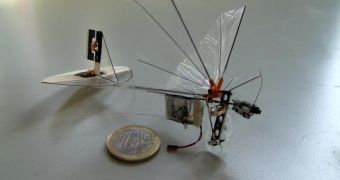Following the creation of DelFly I and II, researchers from TU Delft have now produced their tiniest Micro Air Vehicle to date, the DelFly Micro, weighing a mere three grams and capable of flying much in the same way as a dragonfly. The new MAV is flown by remote control, implies the help of a small camera and image recognition software, can fly at a maximum speed of 5 meters per second and can sustain this velocity for three minutes before its one-gram battery runs out of 'juice'.
The ten-centimeter-long MAV is much smaller than its predecessors, which were created throughout 2005 and 2006. The ultra-small remote-controlled aircraft could eventually make use of its camera to facilitate observation flights in dangerous or hard to reach areas. TU Delft researchers said that the basic principle behind the device was completely inspired from nature.
The camera it carries on board weighs only 0.5 grams, and can transmit signals to a ground station. Even more, the software operating it can recognize individual objects. Due to the high quality of images relayed back by the camera, the DelFly II aircraft can actually be maneuvered from a computer by an operator viewing the images displayed on a monitor, with the help of a joystick control.
The DelFly I, developed in 2005, originally weighed about 23 grams and had a length of 50 centimeters, while the DelFly II aircraft (2006) weighed about 16 grams and measured 30 centimeters, as opposed to the 3 grams and 10 centimeters of the DelFly Micro. As you can observe, the miniaturization process began by the TU Delft researchers in 2005 is continuously evolving.
Two years ago, the DelFly II Micro Air Vehicle came in the spotlight as the smallest known aircraft, capable of reaching velocities of up to 21 kilometers per hour and with the ability to fly backwards. Curiously enough, the latest addition to the MAV collection is unable to perform such actions. A new project is already on the way, named DelFly NaNo, and which is expected to result in the creation of a MAV of only 5 centimeters in length and a weight of 1 gram. Although the DelFly Micro is just a stage in the development processes towards the NaNo, in the near future, it will be given the ability to fly independently thanks to its image recognition software.

 14 DAY TRIAL //
14 DAY TRIAL //